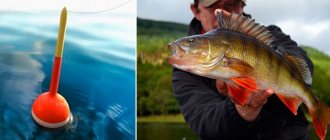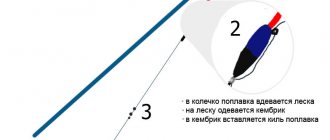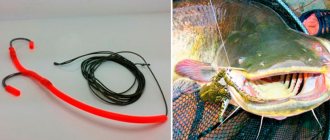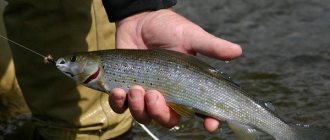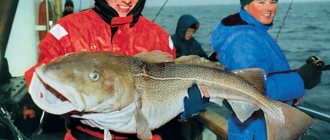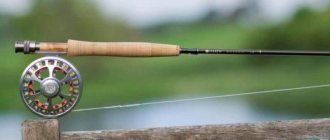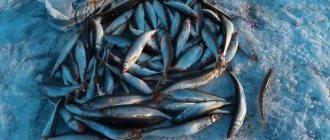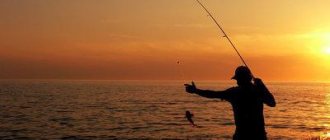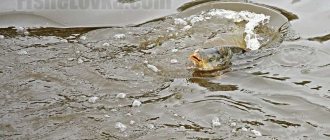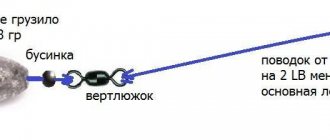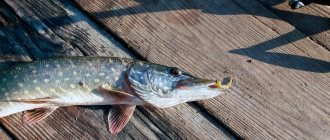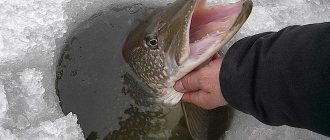Methods for catching coho salmon
Coho salmon in rivers are caught using various amateur gear: spinning, fly fishing, float fishing. In the sea, salmon are caught by trolling and using spinning gear.
Fishing for coho salmon using a spinning rod
Like all salmon, coho salmon are very lively fish, so the main requirement for gear is reliability. It is better to choose the size and test of the rod based on the fishing conditions. Fishing on a lake and river may differ, but you should choose medium-sized baits. Spinners can be either oscillating or rotating. Considering the peculiarities of fishing on fast rivers and possible fishing on a stream, it is necessary to have spinners that hold well in the lower layers of water. The reliability of the tackle must correspond to the conditions for catching large fish, as when catching other Pacific salmon of the same size. Before fishing, you should check the fishing conditions. The choice of rod, its length and test may depend on this. Long rods are more convenient when fishing for large fish, but they can cause discomfort when fishing from overgrown banks or from small inflatable boats. The spinning test depends on the choice of spinner weight. The best solution would be to take with you spinners of different weights and sizes. Fishing conditions on the river can vary greatly, including due to weather. The choice of an inertia-free reel must be associated with the need to have a large supply of fishing line. The cord or fishing line should not be too thin, the reason is not only the possibility of catching a large trophy, but also because fishing conditions may require forced fishing.
Catching coho salmon with a float rod
Coho salmon in rivers react to natural baits. Feeding activity is associated with residual feeding reflexes of migratory forms, as well as the presence of residential subspecies. For fishing, float gear is used, both with “blind equipment” and with “running equipment”. It is worth considering the fishing conditions. Fish are caught both in calm sections of the river and in places with fast currents.
Fly fishing
The fish responds to baits typical of Pacific salmon; the size of the bait should correspond to the possible trophy. The choice of gear corresponds to the experience and desires of the fisherman. As with other medium and large-sized salmon, it is advisable to use high-class gear, including two-handed ones. If you are interested in lighter gear, light-class two-handers and switches may be optimal for fishing. Reacts well to surface flies. This applies to both young individuals and those coming to spawn. Large coho salmon can be caught using “furrow” baits.
Fishing for coho salmon
> What to catch > Other fish > Fishing for coho salmon
One of the most valuable species of fish living in Russia is coho salmon, a representative of the large family of Pacific salmon.
This fish is also called “Kamchatka trout”; in the USA and Canada, coho salmon are called “silver salmon”. Fishing for coho salmon
is mainly carried out in Kamchatka, Sakhalin and some rivers of Eastern Siberia.
Coho salmon are characterized by a thick head with a wide forehead and a short, high caudal peduncle. These characteristics distinguish coho salmon from other species of Pacific salmon. While in ocean waters and at first in river waters, the fish has shiny silvery scales. Its upper head and back may have a bluish or greenish tint. The sides of the body, the upper part of the head and the upper part of the caudal fin are covered with irregularly shaped spots that are black in color.
Shortly before spawning, the body of coho salmon changes, the back and head darken, and the sides acquire a dark crimson color. In the ocean and for a certain period after coho salmon enter the rivers, its meat is pink, but before spawning it becomes yellowish or white and loses its basic taste and beneficial properties.
The habitat of coho salmon is the northern part of the Pacific Ocean, from Norton Bay (Alaska Peninsula) to Monterey Bay. Along the coast of the Asian continent, the northernmost habitat of this fish is the river. Anadyr. Coho salmon spawning occurs from the beginning of October and lasts until December.
Fishing for coho salmon in Kamchatka
– a sea of pleasure and the most vivid impressions. Varieties of Pacific salmon are also often found on the peninsula, such as chinook salmon, chum salmon, sockeye salmon, pink salmon, mykiss, etc., so an experienced spinning angler will always enjoy fishing in Kamchatka.
As usual, the weather conditions of Kamchatka are very peculiar and hardly predictable. Cold winds often blow and it rains; sometimes the wind can be very strong and its gusts can tear down even a fixed tent.
If you want to catch coho salmon
, and you will be the first to go to Kamchatka. What you need to do is think carefully about your equipment. Experienced fishermen who have fished in those places advise you to take thermal underwear with you. You will also need warm, waterproof clothing, gloves, a hat, comfortable shoes, polarized glasses, the simplest tool, a hatchet, a mining shovel, and wire cutters.
For fishing from the shore you will need wading boots, and of course take measures to keep your documents safe. They must be kept in plastic bags, otherwise you risk getting them thoroughly wet.
Often on the way to fishing there are “puddles”, which is how locals generally call healing thermal springs. Swimming in them for longer than 20 minutes is not recommended. Otherwise, instead of healing, you will only harm your body.
Great places to fish for coho salmon in Kamchatka
are located near the city of Ust-Bolsheretsk. There you can find a parking space and leave your vehicle. There is also a small room where there is a representative of the fish and hunting inspector, from whom you can purchase a license to catch fish for a period of 24 hours. You can leave your car there completely calmly and no one will touch it.
The cost of a license is 200 rubles and for every day the fisherman must have a personal license, so if you want to fish for more than a day, you must remember to take care of renewing the license. According to existing standards, five fish can be caught per license. The caught fish must be processed immediately, and it must also be transported outside the fishing area within 3 days from the date of receipt of the license.
Usually you can catch the norm within 1 hour, and then catch coho salmon on a catch-and-release basis. But sometimes you may not catch 5 fish in a day, if, for example, there is a storm at sea and at this time the fish cannot enter the river. You should also know that on the Bolshaya River itself and on the road to it there are police posts and fish protection posts. They control and inspect vehicles and check documents.
In a word, fishing for coho salmon in Kamchatka
, begins with the acquisition of a license; the presence of a passport is a prerequisite for its issuance. The places on the river are wild and remote, the nature is amazing, the impression is spoiled by the frequent blockages of trees both along the banks and in the river. There are a large number of animal tracks everywhere, including bear tracks. So, when fishing you need to keep your eyes open; meeting a clubfoot does not bode well, even if you are fishing in a relatively large group. Local fishermen often take their dogs with them when fishing. At this time, the bear is well-fed and prefers to leave when it hears the dog barking. But if, God forbid, he is hungry, then the dog can serve him as lunch. We must remember that in these places bears have no fear of people at all and even the sound of a gunshot or the noise of a motor boat does not frighten them. Basically, when a bear encounters a person, it prefers to leave, but if you see a bear hunting for fish, it is better not to tempt fate and leave on your own.
The Bolshaya River is formed by the confluence of the Plotnikova, Fast and many smaller rivers and streams. This is the largest river on the western coast of Kamchatka. Its length is more than 300 km, and this river is a favorite spawning place for salmon, of which there are a lot of salmon during the spawning period. Fishing for coho salmon
usually carried out from the second half of August until the beginning of October. The best places are the lower areas of the spawning grounds located closer to the Sea of Okhotsk.
At this time, the number of coho salmon in the river is the densest, the current here is strong, and depths can vary from 1 m. up to 3 meters. They are also found in large pools and whirlpools, where the depth sometimes reaches 8 m. The river bottom is mostly rocky or sandy-rocky. To safely navigate the river on a motorboat, you should stay on the steep banks. It is best if you have a local guide, then you will have a guarantee that you will not get holed or run aground. When you move on a motorboat, logs, bushes, and often entire trees, not to mention logs, float past along the river. This can lead to the fact that while anchored, any of the objects passing by can crash into the boat and cause trouble.
A huge number of coho salmon enter the Bolshaya River, many individuals grow to almost 90 cm in length and can weigh more than 6.5 kg. Males are usually longer and larger than females. On average, individuals weighing 3-4.5 kg and 48-70 cm long are caught on the hook.
The most interesting thing is that coho salmon going to spawn do not feed at all, but aggressively attack the spoon, apparently mistaking it for a predator that wants to feast on its eggs. However, according to another version, coho salmon partially retain their feeding reflexes. Which prompts him to take the bait. Coho salmon fishing
usually occurs in the early morning and evening. From approximately 5 to 10 am and from 17 to 22 pm. During the daytime, fish rest in pits. It is most convenient and also more effective to catch coho salmon from a boat; the craft should be installed on the stream, a few meters from the steep banks, next to a hole or at depth. The boat must be anchored very securely, otherwise it may be torn from its place by a strong current.
Typically for coho salmon fishing
A spinning rod with a dough weight of at least 200 grams is used. A braided line with a diameter of 0.25 to 0.30 mm, with winding rings that can withstand a gap of 30 kg or more, is ideal for equipment. It is also advisable to equip the rod with a Shimano 4000 or 5000 reel.
Many local fishermen use their “Kamchatka rig”. This equipment is a stainless steel rocker with rings, where the main fishing line and a leash with a sinker are attached, the weight of which varies from 100 to 150 grams. A sinker with a leash is attached to the lower part of the rocker, and a light rotating spoon, which has an oval petal and a homemade hook made from 2 doubles, is mounted to its side ring. The main line is attached to the ring in the middle part of the rig through a swivel.
The rig is cast at a distance of 40 to 50 meters, if possible, into a hole or deep place, and then the current is allowed to pull the line. In this case, the spinning rod is installed on a special device, or held in the hands, so that the fishing line is constantly in a taut state. The moment of the bite is determined visually by the tip of the rod or felt by hand. When a coho salmon grabs the bait, it’s immediately clear and usually the fish hooks itself. The fish resists strongly and therefore should not be slack when fishing.
Fishing for coho salmon from the shore
much more difficult than from a boat, it requires special training, good skills and experience. Here you have to constantly be on the move. Fishing should be done from the gentle banks of the river by wading. The bait is thrown to the depths and, if possible, further and a little higher upstream. After the bait has fallen into the water and sunk slightly, you need to start reeling in the fishing line and remember that coho salmon grab the bait halfway through the water.
It is excellent to catch coho salmon at the mouths of small streams and rivers flowing into the Bolshaya, downstream behind large boulders. In some cases, the progress of the fish can be observed from the shore. It is better to use spinners for catching coho salmon that are yellow or light orange, weighing 25-30 grams, type 2Crocodile or Atom-2. Not bad for coho salmon fishing
The Ajlia Long spinner, white No. 4-5, has proven itself. Sometimes loaches and graylings bite on these baits.
Fishing for coho salmon
can bring a lot of pleasure and will be remembered for a long time, the feeling from such fishing is always amazing and the results are always pleasing. You should be aware that local poachers may be fishing near you, catching fish for sale and using any gear, including prohibited ones. Of course, they cause great harm.
By the way, while fishing, you can cook red caviar very tasty, as well as pickle fresh coho salmon meat.
Freshly prepared coho salmon caviar is called “five-minute”.
First, dilute 200 grams of salt in 1 liter of water, and add several raw potatoes to the prepared solution. The solution is then boiled for 10 minutes and then allowed to cool. The eggs containing red caviar are then wiped on a device called a “screen” and then the cooled brine is poured into the bowl with the caviar. The caviar in this brine must be constantly stirred with a wooden spatula for 5 minutes. After this, the caviar becomes harder. Then the brine is drained from the dish containing the caviar through a colander, and the caviar is transferred to a piece of gauze approximately 1x1 meter in size. Next, take the gauze by the corners and roll the caviar in it until all the water is removed and until the smallest particles of film remain on the gauze. After this, the caviar is ready and you can enjoy the extraordinary taste of the fresh delicacy.
Published: 12/23/2013
Other interesting materials:
| Discussion of rods What is the most important tool of a professional fisherman? Undoubtedly his... | All about fishing in the Czech Republic Fishing in the Czech Republic is a promising activity, despite the fact… | Summer Fishing – summer fishing for Android The realism of the summer fishing simulator SummerFishing will not leave you indifferent even... | Fishing in Kalmykia Anyone who thinks that Kalmykia has only steppes and few good reservoirs... |
Lures
Lures for spinning fishing were discussed earlier. When fishing for coho salmon using float gear, various methods of fishing for caviar are used. To do this, they make “tampons”, boil them or mix them with flour, etc. As for fly fishing lures for catching coho salmon, the selection is quite consistent with the choice for other types of Pacific salmon. Do not forget that due to different life forms, it is possible to catch fish of different sizes. Before your trip, you should check the fishing conditions. Various streamers tied in the style are suitable for fishing: zonker, “leech”, “wooly bugger”, it is possible to use baits tied on tubes or other media in the “intruder” style.
